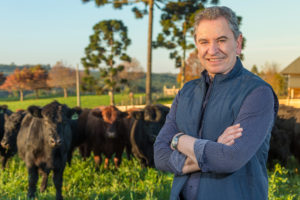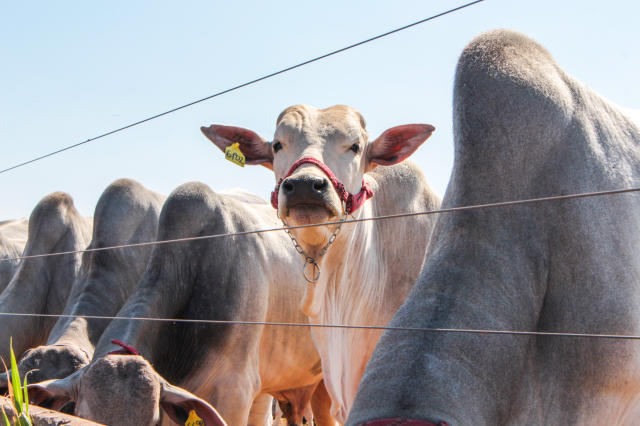São Paulo – Each calf that is born in Brazil today tends to be “better” than the previous generation. As a result of years of research in farms, universities and industries, Brazil now produces a cattle of high productivity, smaller time for slaughter, and an increasingly softer meat. But there’s still a long way to go in the pursuit of perfection – after all, the genetic improvement of animals is still taking its first steps.
The head of the Beef Cattle office of the Brazilian Agricultural Research Corporation (EMBRAPA) in Campo Grande, Mato Grosso do Sul, Antonio Ferreira Rosa explains that the significant gain in quality that Brazil has achieved is due to the choice of animals: the selection of bulls that can produce calves with the best meat, the selection of breed cows with a higher capacity to give birth and produce milk, and the selection of better feeding and better pastures.

“With the selection, we’ve evolved in a remarkable way. The EMBRAPA’s office here in Campo Grande was created in 1977. At that time, a bull used to be slaughtered at the age of five or six. The grass and the soil have been developed since, and the quality of food has improved. With the evolution provided, slaughter went down do 24 to 26 months, the meat is better, more quality. This is reflected in the environment, too, as now we produce more using the same area unit,” he says.
Several traits are involved in improving the cattle. For example, the number of dark pigments in the fur allows the animal to be more resistant to the Brazilian sun and weather. The Nelore breed (pictured above) are naturally more resistant to the heat and parasites, but their meat isn’t historically as tender as the Hereford and Angus breeds. This is changing, however.
Professor of the muscle and flesh tissue class of the department of Animal Science of the Luiz de Queiroz College of Agriculture of the University of São Paulo (ESALQ/USP) Eduardo Francisquine Delgado points out that Brazil only has herds composed entirely of Angus animals in the South region. It is a small herd compared to the national population of 213 million head of cattle. That’s because these animals don’t survive in the hotter regions of the country.
However, technology and the selection processes have recently allowed to obtain good results from the Nelore-Angus cross, which generates a more resistant animal with a softer meat. “We see farmers seek not only to improve the animal but the breeding as well. The genetic basis is still Nelore but there’s a breed mix. The Nelore plus Angs deliverus the (Angus’) tenderness and the Nelore’s rusticity,” Delgado says.
Francisquine says the industry has also contributed for the meat softening process, which can be done through maturation but also physical-chemical processes. Ferreira says that now we can have a wide knowledge of the animal carcass (the part use for food) when it’s still alive through tests. The result? A higher productivity.
Brazilian Angus Association president and breeder Nivaldo Dzyekanski says that Angus is an “improver” of the quality of the meat. “It has the ability to pass on its quality, it’s a natural improver,” he says. “And it’s true it struggles with heat.”

Dzyekanski explains the association and EMBRAPA in Bagé, Rio Grande do Sul, will develop a work to identify animals that are able to better withstand heat, have a smoother fur and are more resistant to ticks. In addition to being an improver of the Zebu herd, which includes the Nelore breed, Angus has its captive customers. There’s a niche that seeks for the meat of this animal, which has more intramuscular fat. In the foreign market, the mentions China and the United States as countries that seek softer meats.
ESALQ’s Delgado adds that Brazil is an example of the animal’s health quality and traceability processes. But there’s a very specific trait to determine what quality is. “There are intrinsic sensorial aspects that vary according to each country’s consumer culture. Even here in Brazil, what a group sees as good may not have the same value for other,” he says.
Still, the consumers’ taste makes the farmers seek the best meat. One can go to a bull’s DNA and see if there’s markers indicating of it could produce a calf with a specific trait, such as a tender meat. From then on, it can pass this trait on to its calves, which could have a softer meat.
The selection and artificial insemination, which is done in around 16% of the reproductive processes in Brazil, are the main methods in pursuing the best animal. There’s also cloning. But a cloned animal gets not only the qualities but the defects of the original animal as well, such as a predisposition to certain diseases. “Gene editing is a reality in some countries, such as the US. That’s the future but there’s a long way to go,” Ferreira says.
Special report from Marcos Carrieri for ANBA.
Translated by Guilherme Miranda




